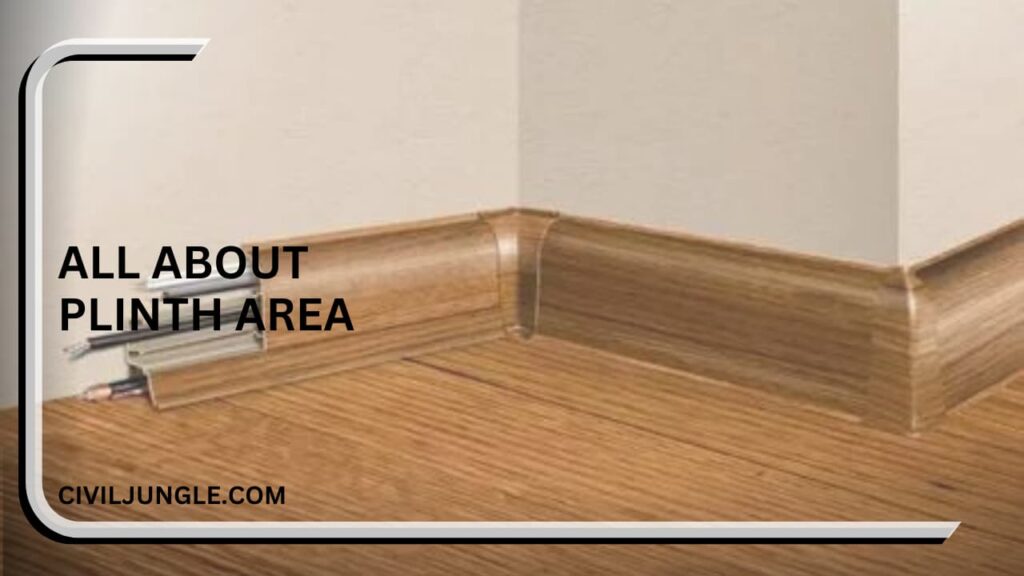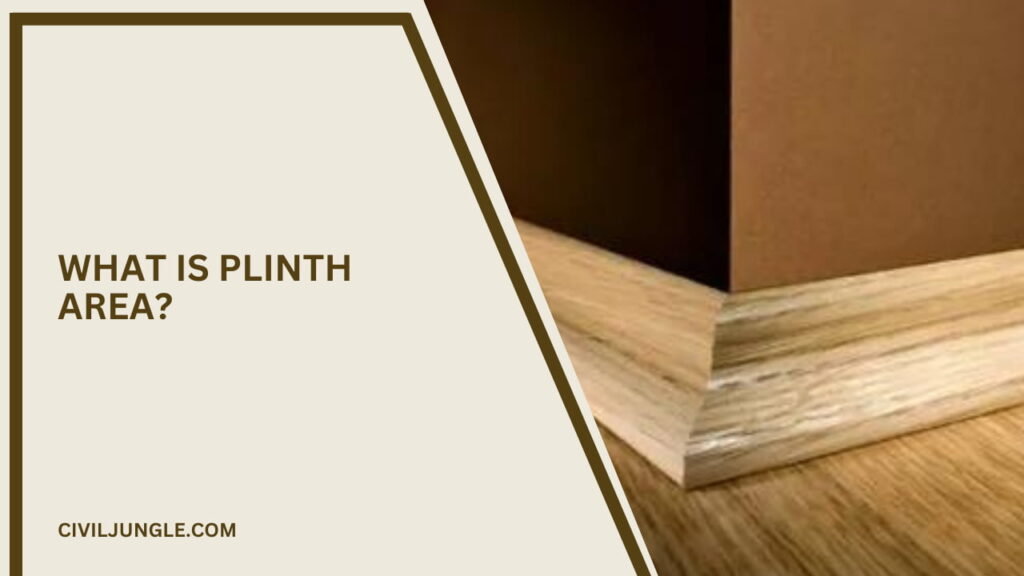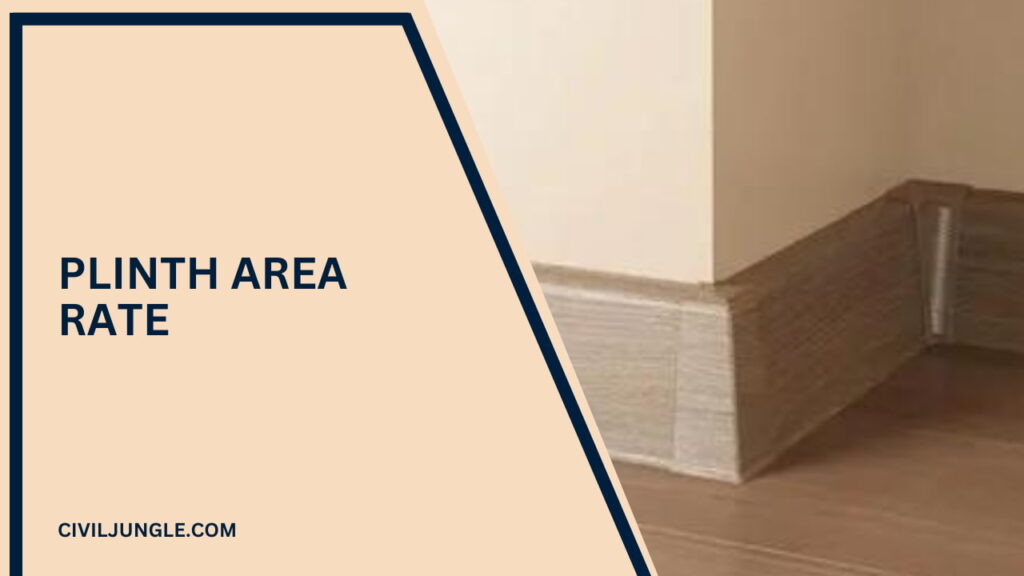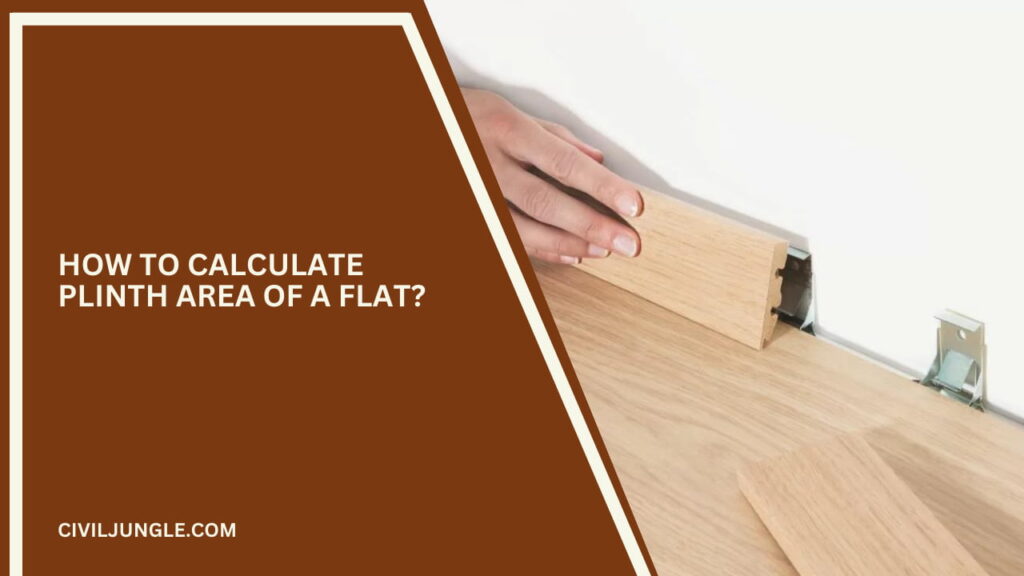Plinth Area Meaning:
Important Point
The plinth area means we know the built-up covered area at the floor level of the basement or of any story.
The plinth area is also referred to as the total area captured by the building along with the interior or exterior wall and also known as the built-up area.
The plinth area length of a building should be calculated to adjacent 1 inch if the measuring unit is in feet. The plinth area of the building normally remains 10 to 20 % over the carpet area.
Also, Read: What Is Plinth | What Is Plinth Protection | Purpose of Plinth Protection
Plinth Area Definition:
The definition of the plinth area is that the plinth area is a total area captured by the building along with the interior or exterior wall and also known as the built-up area.
The plinth area is a built-up covered area at the floor level of the basement or of any story.
What Is Plinth Area?
The Plinth area is the total area from the external wall to the external wall and also to the internal wall to the internal wall which is sometimes related to the Carpet area.
The plinth area is also referred to as the total area captured by the building along with the interior or exterior wall and also known as the built-up area.
The plinth area is a built-up covered area at the floor level of the basement or of any story.
The plinth area of the building normally remains 10 to 20 % over the carpet area. The plinth area length of a building should be calculated to adjacent 1 inch if the measuring unit is in feet.
Also, Read: Difference Between Plinth Level, Sill Level, and Lintel Level.
Plinth Area Rate:
The Plinth Area Rate is divided into three parts. Which is as follows.
- For Residential.
- For Non-Residential Building.
- Hospital Building.
#1. For Residential-
- For load-bearing structure, the foundation plinth area rate per 1 sq.m. is 3870, super-structure is 8625, and finishing 1450.
- And for frame structure, the super-structure plinth area rate per 1 sq.m. is 12025, and the finishing 1530.
#2. For Non-Residential Building-
- For load-bearing structure, the foundation plinth area rate per 1 sqm is 2980, super-structure is 7310 and finishing is 1495.
- And for frame structure, the foundation plinth area rate per 1 sqm is 4590, super-structure is 9035, and finishing is 1530.
#3. Hospital Building-
- For load-bearing structure, the foundation plinth area rate per 1 sq.m. is 2970, super-structure is 8190, and finishing is 1495.
- And for frame structure, the foundation plinth area rate per 1 sq.m. is 4590, super-structure is 12535, and finishing is 1530.
Plinth Area Estimate:
The plinth area length of a building should be calculated to adjacent 1 inch if the measuring unit is in feet. The plinth area length of a building should be computed adjacent to 0.01 m and the area should be rounded to 0.01 m2.
When we estimate the plinth area of a building the following areas should be into consideration.
- At the floor level the area of the wall without plinth offsets. Half of the area of such walls should be contained in the plinth area if any common walls exist among two buildings.
- The plinth area is estimate up to the outside of the cladding if the building contains columns that are proposed outside the cladding.
- The lift well along with landing and the vertical duct for air conditioning are should be estimated.
- At the floor level the area of the wall without plinth offsets. Half of the area of such walls should be contained in the plinth area if any common walls exist among two buildings.
- 50% of the area should be taken into consideration if the area is uncovered with projections.
- The bay window is the perfect instance and the recess by cantilevering apart the exterior walls.
- 25% of such an area should be considered when the recess height is up to 1.0 meters.
- And when the recess height is 1.0 to 2.0 meters, 50% of such area should be considered. but the recess height is considered 0 meters, 100% of such area should be considered.
- The estimate of plinth Areas of the internal shaft for sanitary installations and garbage chute, telecom, electrical, and firefighting services under the condition that these do not go beyond 2m2 in the area.
Also, Read: 10 Different Types of Loads on Structures| What Are Structural Loads
How to Calculate Plinth Area of a Flat?
- The plinth area length of a flat should be calculated to adjacent 1 inch if the measuring unit is in feet. The plinth area length of a flat should be computed adjacent to 0.01 m and the area should be rounded to 0.01 m2. When we estimate the plinth area of a flat the following areas should be into consideration-
- The plinth area is calculated as a flat up to the outside of the cladding if the building contains columns that are proposed outside the cladding.
- To the calculation of the plinth area of a flat 50% of the area should be taken into consideration if the area is uncovered with projections.
- The bay window is the instance and the recess by cantilevering apart the exterior walls.
- To calculate the plinth area of a flat at the floor level the area of the wall without plinth offsets. Half of the area of such walls should be contained in the plinth area if any common walls exist among two flats.
- And when the recess height is 1.0 to 2.0 meters, 50% of such area should be considered. but the recess height is considered 0 meters, 100% of such area should be considered.
- The calculate of the plinth area of the flat the internal shaft for sanitary installations and garbage chute, telecom, electrical, and firefighting services under the condition that these do not go beyond 2m2 in the area.
- The lift well along with landing and the vertical duct for air conditioning are should be calculated.
In the Calculation of Plinth Area, Some Things Should Be Considered That’s Are?
- The plinth area of the ground level of the building should be taken for the calculation of the foundation coast.
- The plinth area should be taken for the calculation of super-structure cost knows
- The plinth area at the Ground level of the building is to be taken for the calculation of the roof slab finishing.
- the Super Structure cost will be 80% of the Super Structure cost of Non-Residential Buildings for the school building.
- the rates in Annexure-V shall be adopted, For super-structure in earthquake-prone areas.
- The Sea Water Front – Rs.243/m2 up to 10 km distance.
- the basic rates as approved in the table above the provisions should be taken.
- an extra 25% over the superstructure cost of the respective type of building is to be added for the basement floor.
- In the plinth area calculation for the upper floors, an extra Rs.34/ m2 should be added towards each lift charge.
- The schedule of rates for works in Jails, Hills, Reserve forests, and other Special tracts, etc. The additional rates allowed shall be due to the above plinth area rates for works in respective areas.
- The basic rate of the above data, all the provisions should be added.
- The following rates over the basic rate as approved in the above data, the concrete provided in a higher grade in the coastal areas.
Also, Read: Floating Slab Vs Monolithic Slab | What Is Monolithic Slab | What Is Floating Slab
Plinth Area Meaning
Plinth Area means built-up area of the Apartment + Proportionate area of common spaces in that floor. Plinth Area means the built up covered area of the building / buildings immediately above plinth level.
Plinth Area
Plinth Area the built up covered area measured at the floor level of the basement or of any storey including balconies but excluding ducts/ services and lift shaft (except in the lowermost floor of lift shaft) and open cut-out areas.
Plinth Area Definition
Plinth area shall mean the built-up covered measured at the floor level of the basement or of any storey ( see 4 ). 2.2 Carpet Area. Carpet area shall mean the floor area of the usable rooms at any floor level ( see 5 ).
How to Calculate Plinth Area of a Flat?
Plinth area is also called as built-up area and is the entire area occupied by the building including internal and external walls. Plinth area is generally 10-20% more than carpet area. Carpet area the covered area of the usable spaces of rooms at any floor.
What Is Plinth Area?
Plinth area is also called as built-up area and is the entire area occupied by the building including internal and external walls. While carpet area is the covered area of the usable spaces of rooms at any floor.
How Do You Calculate Plinth Area?
It is also referred to as the total saleable area. Mathematically, Plinth Area= Carpet Area of the building + area of the balcony + areas of the walls.
What Is the Difference Between Plinth Area and Floor Area?
Generally , the plinth area is calculated by taking the external dimensions of the building at the floor level. Whereas while calculating the floor area the internal measure is mandatory to lay the carpet which does not include the thickness of the walls and an internal measure.
What Is Plinth Area in India?
Plinth area is also called as built-up area and is the entire area occupied by the building including internal and external walls. Plinth area is generally 10-20% more than carpet area.
What Is Plinth Area and Plot Area?
The built-up area, also called the Plinth area, is the total area provided for use. The Super built-up area includes the common spaces like the park, playgrounds, gym, and other utilities common to the residents. The plot area is the land area between the fencing.
Is Verandah Included in Plinth Area?
In plinth area veranda, balconies and parapets is included, if these area is secured by projections, in plinth area full area is included, if the area of veranda, balconies and parapets etc. is un-secured by projections then 50% of the area is included.
What Is the Height of Plinth?
It is the part of the superstructure between natural ground level and Finished floor level. the plinth is provided to restrict the seepage of stormwater and rainwater into the building. The plinth height is in between 300mm – 450 mm from ground level.
Is Car Porch Included in Plinth Area?
But while calculating the plinth area of a building other than a residential building, the plinth area of a car porch cannot be excluded.
What Is Included in Plinth Are?
Plinth Area means the built up covered area measured at the floor level of the basement or of any storey including balconies but excluding ducts/ services and lift shaft (except in the lowermost floor of lift shaft) and open cut-out areas.
What Does Plinth Area Mean?
Plinth Area means built-up area of the Apartment + Proportionate area of common spaces in that floor. Plinth Area means the built up covered area of the building / buildings immediately above plinth level.
Is Covered Area Same as Plinth Area?
Plinth area is the covered built-up area measured at the floor level of any storey or at the floor level of the basement. Plinth area is also called as built-up area and is the entire area occupied by the building including internal and external walls.
What Is the Use of Plinth?
The plinth distributes that weight outwards, dispersing it more evenly through the ground or floor. That’s the most important function of a plinth; however, it can also be used to physically separate structures like houses from the ground. This is especially important if the ground is not solid, stable, or dry.
What Is Plinth Area and Common Area?
Plinth Area. The built-up area or Plinth area is Carpet Area plus the area the walls occupy in your home. Super Built-Up Area. The super built-up area takes into account the common areas. Examples are apartment’s proportionate share of the lobby, staircase, elevator and the corridor outside the apartment.
What Is Plinth Area and Floor Area?
Plinth area is the covered built-up area measured at the floor level of any storey or at the floor level of the basement. Plinth area is also called as built-up area and is the entire area occupied by the building including internal and external walls. Plinth area is generally 10-20% more than carpet area.
What Is Plinth Area of a Plot?
The total building area in plot area is referred as Built up area. In simple, Area excluding empty space around the building is called Built up area or Plinth area.
Is Porch Included in Plinth Area?
Porch. Open projections of veranda, balconies and parapets, if the area is protected by projections, full area is included in plinth area, if the area is un-protected by projections, 50% of the area is included. Recess by cantilevering beyond external walls, bay window is the best example.
How to Calculate Plinth Area of a Flat?
To calculate the plinth area of a flat at the floor level the area of the wall without plinth offsets. Half of the area of such walls should be contained in the plinth area if any common walls exist among two flats. And when the recess height is 1.0 to 2.0 meters, 50% of such area should be considered.
What Is Plinth Area of a Flat?
Plinth Area means the built up covered area measured at the floor level of the basement or of any storey including balconies but excluding ducts/ services and lift shaft (except in the lowermost floor of lift shaft) and open cut-out areas.
How Is Plinth Cost Calculated?
The cost of construction is determined by multiplying the plinth area with the plinth area rate. The area is obtained by multiplying length and breadth (outer dimensions of the building).
Plinth Area Calculation
It is also referred to as the total saleable area. Mathematically, Plinth area/ Built-up Area= Carpet Area of the building + area of the balcony + areas of the walls.
What Is Plinth Area Estimate?
Plinth area and carpet area of a building is measured for estimation and calculation of building cost. Plinth area is also called as built-up area and is the entire area occupied by the building including internal and external walls. Plinth area is generally 10-20% more than carpet area.
Plinth Area of Building
Plinth Area means the built up covered area of the building / buildings immediately above plinth level. Plinth Area means the built-up covered area measured at the floor level of the basement or of any storey whichever is larger.
How Do You Find the Plinth Area of a Building?
Plinth area is the area that is calculated by adding the carpet area of the building and the thickness of the walls of the building. Super built-up area is the area that is calculated by adding the plinth area and the external spaces and projections such as the lobby, elevators, etc.
Is Plinth Area and Built Up Area Same?
Built Up Area or Plinth Area is the total covered area of the apartment or commercial property unit.
Does Built Up Area Include Balcony?
‘Built-up Area’ is the carpet area plus the areas covered by inside and outside walls, balconies and verandahs attached to the unit for exclusive use.
Plinth Area Formula
It is also referred to as the total saleable area. Mathematically, Plinth area/ Built-up Area= Carpet Area of the building + area of the balcony + areas of the walls.
Difference Between Plinth Area and Floor Area
Plinth area is the covered built-up area measured at the floor level of any storey or at the floor level of the basement. Plinth area is also called as built-up area and is the entire area occupied by the building including internal and external walls. Plinth area is generally 10-20% more than carpet area.
Difference Between Plinth Area and Built Up Area
Plinth area is the covered built-up area measured at the floor level of any storey or at the floor level of the basement. Plinth area is also called as built-up area and is the entire area occupied by the building including internal and external walls. Plinth area is generally 10-20% more than carpet area.
Is Plinth Area and Floor Area Same?
Floor area is similar to carpet area. Plinth Area or Built-Up Area means total covered area of the building unit. It is measured by adding areas of utility ducts surrounded by property unit, internal and external walls to the carpet are. It covers 10 to 20% more area from carpet area.
Plinth Area and Carpet Area
Plinth area is the covered built-up area measured at the floor level of any storey or at the floor level of the basement. Plinth area is also called as built-up area and is the entire area occupied by the building including internal and external walls. Plinth area is generally 10-20% more than carpet area.
What Is Plinth Area in Building?
Plinth Area means the built up covered area measured at the floor level of the basement or of any storey including balconies but excluding ducts/ services and lift shaft (except in the lowermost floor of lift shaft) and open cut-out areas.
How to Calculate Plinth Area of a House?
Plinth area = building carpet area + wall area (both internal and exterior walls) + parasitic area + elevator openings, etc. The plinth area is the space between the building’s exterior and outer bounds or its walls.
Plinth Area Vs Built-Up Area
Both terms have similar meanings and are used interchangeably. Usually, the plinth area is used for independent houses and villas whereas the built-up area is used for apartments and builder floors.
Plinth Area in Construction
The plinth area is the area that lies within the outer-to-outer dimensions of the walls of the building and is obtained by multiplying the out-to-out dimensions of the building at any floor level. Note, space covered by pillars, pilasters, and other intermediate support are not calculated in the floor area.
Plinth Area as Per Building Regulations
The plinth area of a building or structure is the area of the ground covered by the building or structure, excluding any part of it that is above ground level. The plinth area of a building is equal to the gross floor area minus the base area (or basement) of that building.
Plinth Area Measurement Standards
The plinth area is therefore the covered built-up area that is measured at the floor level of any storey of a building, or even at the floor level of the basement of a building. It measures the total area and is generally 10 to 20% higher than the carpet area.
Carpet Area Means
What is the Carpet Area? The area of an apartment that can be covered by a carpet or the net usable area is known as the carpet area. It is the distance between the inner walls. The carpet area would include the areas of the bedroom, living room, kitchen, bathrooms, balconies & staircases within the house/flat.
Plinth Area Vs Carpet Area
The plinth area is the space between the building’s exterior and outer bounds or its walls. The carpet area is the sum of the actual areas of the rooms that you can carpet. The plinth area is 10 to 20% greater than the carpet area. The carpet area is smaller than the plinth area by 10 to 20%.
What Is Plinth Area?
The plinth area or built-up area is the space covered by the floor of the property, along with the area covered by its internal and external walls. Both terms have similar meanings and are used interchangeably.
How to Calculate Plinth Area?
Plinth area = building carpet area + wall area (both internal and exterior walls) + parasitic area + elevator openings, etc. The plinth area is the space between the building’s exterior and outer bounds or its walls. The carpet area is the sum of the actual areas of the rooms that you can carpet.
What Is Plinth Area Estimate?
A Plinth area estimate is done based on the plinth area of a building. It is the approximate cost estimate in which a building’s plinth area is multiplied by the prevailing plinth area rate to get the building cost.
Plinth Height
The height of the plinth is generally kept between 300mm to 450mm above the natural ground level. The lintel height mostly adopted for the residential building is 7′ (2130 mm) and 7’6” (2316 mm )for the commercial buildings.
plinth area rate
Plinth Beam
A plinth beam is a rectangular stone block that supports the pillars and sub-columns of a building. It serves as a wall dividing the ground floor from the ground level. The primary purpose of a plinth is to distribute the weight of the columns across the foundation uniformly.
Like this post? Share it with your friends!
Suggested Read –
- Acp Sheet
- Low E Meaning
- Carpet Area Meaning
- Parapet Wall Definition
- Residential House Meaning
- What Is Dressing of Stone | Types of Dressing of Stone
- Floating Slab Vs Monolithic Slab | What Is Monolithic Slab | What Is Floating Slab
- RCCFull Form | What Is RCC | Advantages & Disadvantages of Reinforced Cement Concrete | Properties of RCC | What Does RCC Stands for
- What Is a Cavity Wall | How to Build a Cavity Wall | Cavity Wall Detail | Cavity Wall Thickness | Cavity Wall Insulation Pros and Cons | Brick Cavity Wall
- What Is Oblique Drawing | Oblique Drawing Examples | What Is Oblique View | Oblique Projection | Oblique Shape | Cabinet Oblique | What Is Cavalier Drawing
- Which of the Following Is a Way That Slopes Fail | Types of Slope Failure | Geotechnical Failures | Types of Slopes in Geography | Causes of Slope Failure | Slope Stability
- What Is Pier and Beam Foundation | Advantages & Disadvantage of Pier and Beam Foundations | Pier and Beam Foundation Design | How to Build a Post and Pier Foundation
Originally posted 2023-08-02 19:06:52.






Leave a Reply